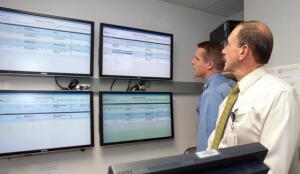AHRA: Can NASA scheduling software help reduce staff overtime?
by
Brendon Nafziger, DOTmed News Associate Editor | August 18, 2011

On-Cue in the
IR department (Credit:
Allocade)
University of Utah Healthcare researchers say an artificial intelligence program developed by a former NASA computer scientist helped organize its interventional radiology department, cutting staff overtime by 90 percent.
In a poster presentation at the AHRA's annual meeting in Grapevine, Texas this week, the department's manager said software that uses an artificial intelligence engine to track and rank staffing and resource demands helped reduce both patient wait-times and payroll costs.
According to the abstract of the report, presented by Steven Tew, the department's manager, the academic hospital's interventional radiology department faced complex scheduling problems. For one, the busy hospital system's radiology department performs around 3,000 procedures a year.
Another problem is that the IR procedures are split between four rooms. To add to the complexity, the department is actually stretched out over two campuses in Salt Lake City, the main hospital and the Huntsman Cancer Institute, which is a 10-15-minute walk away.
"The difficulties were both (about) multiple locations as well as just allocating the appropriate time," Tew told DOTmed News by phone.
Large whiteboards were used to keep staff organized, but these often had to be supplemented by calls, pages and face-to-face meetings. After evaluating its scheduling challenges, the department decided to make the process more efficient. So in 2009, they turned to On-Cue, an operations program developed by Allocade Inc. of Menlo Park, Calif.
The software, first released in 2008, was originally conceived by Don Rosenthal, Allocade's co-founder who led the Artificial Intelligence Applications Group at the NASA Ames Research Center. Apparently, the roots of the software lie with Rosenthal's work in setting up a scheduling system for the Hubble Space Telescope, according to materials provided by Allocade and NASA.
The system works through a command center that shows the charge nurse or administrator historical and real-time data on scheduling, letting staff adjust scheduled blocks for patients based on known trends.
"We were able to adjust the time that we were scheduling cases and increase our throughput because we weren't scheduling too long for some cases and too short for others," Tew said. "We were able to look by physician what their average time was per case, and adjust the schedule accordingly."
The hospital estimates it was able to increase patient throughput by approximately 18 percent, reduce overtime by 90 percent, and cut full-time equivalent expenses by 10-15 percent.
Tew said in addition to cutting patient wait-times, they were able to make waiting less irksome. For instance, if patients come early to an appointment, by glancing at the scheduling chart, staff can give a more realistic window of how long they have to wait.
"In the past, they might have gotten frustrated waiting, and now we can say, 'Hey, this is what you can expect,'" he said.
The IR department said the technology will also help with its expansion plans: soon there will be two more IR rooms, one in the Clinical Neuroscience Center on campus, another in the South Jordan Health Center across the valley.
"We feel that it more than paid for itself," Tew said.
|
|
|
You Must Be Logged In To Post A Comment
|
